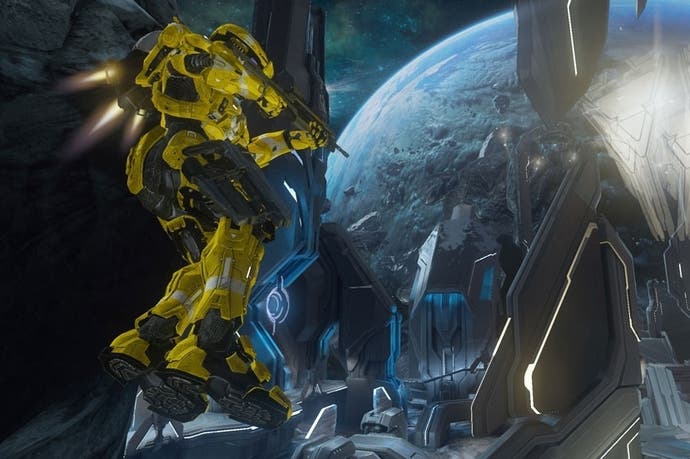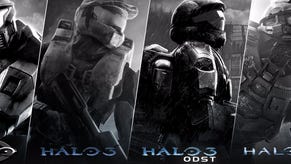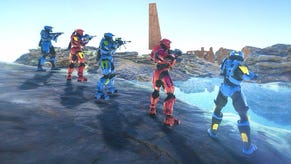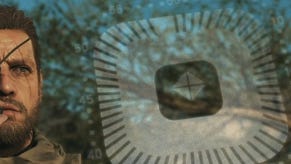Halo 4: Majestic Map Pack review
Small is beautiful.
Reviewing a map pack is weird. It's like the old adage that says writing about music is like dancing about architecture. The mechanics, the gameplay, everything that we'd normally sink our teeth into is a known quantity. What we're really doing is reviewing a space and how people move through it - an abstract thing to pin down at the best of times. It's like town planning with heavy ordnance.
That being the case, the Crimson Map Pack, Halo 4's first selection of additional arenas, was a lot like a bland new town from the 1970s. Functional but devoid of personality, and probably full of roundabouts and shopping arcades. To stretch this dubious metaphor beyond breaking point, the Majestic Map Pack offers vibrant and lively old-fashioned villages with everything you need right on your doorstep. Which is another way of saying that these three maps offer the sort of compact and punchy close-quarters locations that made Halo such a multiplayer mainstay in the first place.
Let's start with Skyline, a tight, two-storey structure set at the base of a space tether construction site. It's downright tiny by current Halo 4 map standards, a jumble of ramps, stairs, short corridors and balconies all piled on top of each other. There's an elevator for rapid transit to the upper level, but you'll rarely need it. Those with the jetpack armour ability will be able to hop freely from one to the other in seconds, while agile players with an eye for parkour-style routes will quickly work out the scenery items that can act as stepping stones. Failing that, wherever you turn, there's always a way up or down.
Like all three Majestic maps, it's absolutely perfect for free-for-all matches. Rounds are brutal and fast and you'll always spawn within spitting distance of the action. Most of the combat tends to get contained in the loop of rat runs around the edge of the map, but there's a small open-plan area in centre that provides ample cover behind consoles and crates. Some cunning placements mean it also works a treat for Capture the Flag, the confined spaces making for quick, desperate dashes back to base to score.
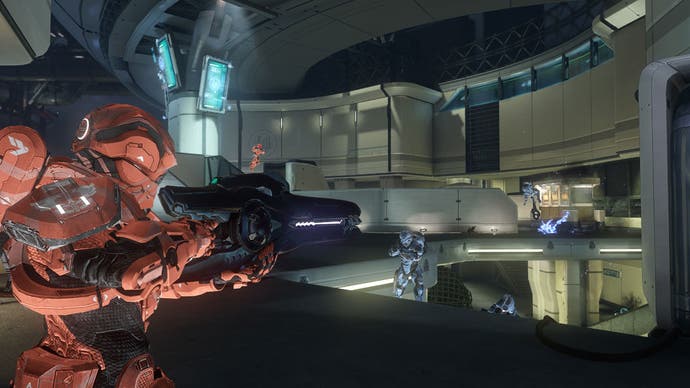
Aesthetically, it's not the most dazzling location - in fact it feels a lot like things have kicked off in the Apple Store. It earns its title when you reach the side of the map that opens out onto a panoramic view. The half-built tether towers above you while a glittering city stretches into the distance with tiny dots of traffic trundling along. Two ominous moons hang in the dark blue cloudy sky, and if you watch long enough, you'll see a Hornet taking off in the distance and heading away to some trouble spot. It's a wonderful bit of visual sleight of hand, a fake backdrop that looks invitingly real - the saddest thing about it is that players will soon get used to it so you won't get quite so many easy melee kills from people stopping to gawp at the view.
Landfall is the largest map, though it's still a long way from the sprawling arenas that Halo 4 shipped with. Set on the planet Tribute during a Covenant invasion, the map covers a UNSC staging area with long open spaces punctuated by cargo containers for cover. An uncovered dock area offers another gorgeous background view - this time of Covenant ships laying waste to buildings across the water - while interior areas take in workshops and garages, with broken-down vehicles offering hefty obstructions. Almost all the map takes place at ground level, but there are a few elevated positions for snipers willing to expose themselves.
Similar in style to The Pit from Halo 3, Landfall matches are a bit less frantic than those on the other Majestic maps and if you prefer a more tactical style of objective-based team play then this is the one for you. There's room to coordinate your actions more carefully, rather than always being forced into a reactive position, and the distances you need to cover are such that there's time to strategise a little.
The best of the bunch is Monolith, however. Set on an asteroid covered in Forerunner architecture, this is a map that harks back to the very early days of Halo multiplayer. The alien setting means there's no attempt to pretend this is a real place where combat just happens to have broken out - it's a pure video game arena, obviously designed for maximum chaos.
A refreshing focus on the simple, old-fashioned charms of taut design that works without clumsily obvious player funnelling - it's 2002 all over again.
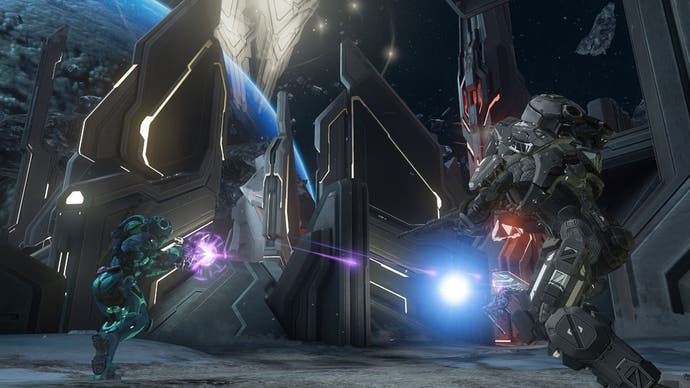
Symmetrical and busy, at ground level there are very few places where you'll have the luxury of seeing the enemy from a distance. A small building in the centre of the map with a round hole in the ceiling makes for a delicious challenge in King of the Hill matches. Allow the other team to get above you and you're fish in a barrel. Man Cannon launch pads offer a graceful way to catapult yourself over the middle of the map, while elevators to the side allow for fast access to the raised structures at each compass point. There are also a couple of short rocky pathways around the outside for those who fancy attempting some flanking manoeuvres.
What impresses most about Monolith is how it frees up your movement. The Forerunner structures are all slopes, curves and steps, so rather than constantly hemming you in, almost everything can also act as a way to get up high. This map was made for jumping, and that's just what you'll do. As a result, Slayer matches played here are an absolute joy, with Spartans springing and sprinting in every conceivable direction. It's a real throwback to the classic Halo multiplayer of 10 years ago.
This nostalgic element rubs awkwardly against Halo 4's more modern multiplayer structure, however. Old-school maps such as these are crying out for a return to straightforward mano-a-mano arena combat where victory came purely because you played well in that match, not because grinding XP had given you a vastly superior arsenal and the ability to soak up hits. It's no exaggeration to say that Monolith is one of the best Halo maps in years, but any newcomer picking up the game now will probably struggle to appreciate its benefits thanks to one-hit kills from guys with over-powered weaponry.
In adopting the classic approach, these maps shine an unflattering light on the CODification of Halo, but it's pointless denying that they do their job. No vehicles, the bare minimum of environmental gimmicks or gadgets and a refreshing focus on the simple, old-fashioned charms of taut design that works without clumsily obvious player funnelling - it's 2002 all over again. If you still pine for rigidly contained maps like Battle Creek, Turf or even the relatively recent Guardian, then the Majestic Map Pack lives up to its name.
